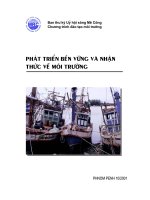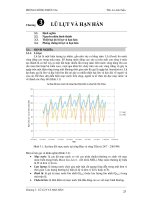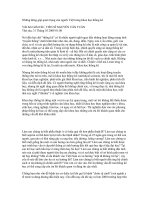MOUSETRAP CARS docx
Bạn đang xem bản rút gọn của tài liệu. Xem và tải ngay bản đầy đủ của tài liệu tại đây (13.73 MB, 32 trang )
• A vehicle
p
owered b
y
the
py
spring device of a
mousetrap
•
A mousetrap is a simple
fulcrum
•
A
mousetrap
is
a
simple
machine because it uses
mechanical advantage to
lti l f
applied
force
mu
lti
p
l
y
f
orce
• The mousetrap acts as a
third
-
class lever with the
resultant force
(load)
third
class
lever
,
with
the
spring as the fulcrum and
the hammer as the load
•
How does the power source work?
How
does
the
power
source
work?
– The spring propels the hammer, which causes an enormous release
of energy
–
The hammer is connected to a string that is wound around the drive
The
hammer
is
connected
to
a
string
that
is
wound
around
the
drive
axle
– The string unwinds as the hammer snaps– making the car roll!
(from Doc Fizzix’s
Mousetrap Powered
Cars & Boats)
• There are some im
p
ortant scientific conce
p
ts
pp
involved in building a mousetrap car
–
we’ll
consider a few of them here:
–
Potential Energy
–
Potential
Energy
– Kinetic Energy
–
Force
–Friction
– Torque
– Power
• Potential Ener
gy
: ener
gy
that is stored within
gy
gy
an object, not in motion but capable of
becoming active
You have stored potential energy (in the
–
You
have
stored
potential
energy
(in
the
spring) when your mousetrap is set and ready
to be released
• Kinetic Energy: energy that a body possesses
as a result of its motion
–
Potential energy becomes kinetic energy as
Potential
energy
becomes
kinetic
energy
as
the mousetrap car begins to move
– Some of this energy goes to friction– the rest
k!
ma
k
es your car go
!
F
ih l
•
F
orce: an act
i
on t
h
at causes a mass to acce
l
erate
– To change the motion of your mousetrap car, you must
a
pp
l
y
a force
pp y
– To increase the acceleration of you car, you must
increase the force or decrease the mass (Newton’s
Second Law)
• Friction: the force that opposes the relative motion
of two surfaces in contact
F i ti ill l
dtllt
t
–
F
r
i
c
ti
on w
ill
s
l
ow
–
an
d
even
t
ua
ll
y s
t
op
–
your mouse
t
rap
car
– Friction occurs between the wheels and the floor and
between the axle and the chassis
between
the
axle
and
the
chassis
T
if ll b h h f " i l
•
T
orque: can
i
n
f
orma
ll
y
b
e t
h
oug
h
t o
f
as
"
rotat
i
ona
l
force" or "angular force" that causes a change in
rotational motion
– In your mousetrap car, the snapper arm applies a
force to the drive axle through the pulling string. This
in turn causes a tor
q
ue to be
p
roduced around the
qp
drive axle.
(f
(f
rom Doc Fizzix’s
Mousetrap Powered
Cars & Boats)
P
hhihkid i
•
P
owe
r
: t
h
e rate at w
hi
c
h
wor
k
i
s
d
one or energy
i
s
used
–
In a mousetrap car, the same overall amount of
In
a
mousetrap
car,
the
same
overall
amount
of
energy is used regardless of its speed – only the rate
of use changes
–
For
distance
you want to use energy slowly (energy
–
For
distance
,
you
want
to
use
energy
slowly
(energy
goes into distance instead of speed)
–For power, you want to use it more quickly (lots of
energy needed at the start to get the car moving up
energy
needed
at
the
start
to
get
the
car
moving
up
the ramp)
–For accuracy, a balance is important (enough power
ththttbttltf df
t
o reac
h
th
e
t
arge
t
,
b
u
t
no
t
a
l
o
t
o
f
energy save
d
f
or
the end so braking will be easier)
• When buildin
g
a mousetra
p
car
,
there are a
gp,
number of variables to conside
r
– Weight of the car
f
–
Placement o
f
the mousetrap
– Length of the snapper arm and the string
Si e and t pe of heels
–
Si
z
e
and
t
y
pe
of
w
heels
– Wheel-to-axle ratio
•
Your design decisions will depend on the goal
•
Your
design
decisions
will
depend
on
the
goal
of your car: distance, accuracy, or power
vehicle
– Lighter vehicles will require less force to begin
moving and will experience less friction than heavier
moving
and
will
experience
less
friction
than
heavier
vehicles
• However, if your car is too light, it will not have
enough traction
enough
traction
– This will cause the wheels will spin out as soon as
the trap is released
Ldht
Power
•
L
ong snapper arms an
d
s
h
or
t
snapper arms
release the same amount of energy
– The difference lies in the rate at which the
energy is released (power output)
Power
Distance
•For distance cars, try a long arm. Longer
arms will provide less force, but more distance.
– With a longer arm, more string will be pulled off
the axle
– This causes the wheels to turn more times and
allows the vehicle to cover more distance
•For accuracy cars, the length of the snapper
arm will depend on the length of the string
–
arm
will
depend
on
the
length
of
the
string
–
more on this in a minute
•For power cars, try a shorter arm. Shorter
arms will provide more force and power output,
but less distance
but
less
distance
.
– These cars need the power to get up the ramp!
(from Doc Fizzix’s Mousetrap
Powered Cars & Boats)
•
For
all cars
the lever arm should just reach the
•
For
all
cars
,
the
lever
arm
should
just
reach
the
drive axle when it’s in the ready position
• When the string is wound, the place where the
string is attached to the snapper arm should be
string
is
attached
to
the
snapper
arm
should
be
above the drive axle
– This will maximize your torque as your car takes off
(maximum torque occurs when your lever arm and
(maximum
torque
occurs
when
your
lever
arm
and
string form a 90
° angle)
Correct
Too long!
(f
Correct
length
Too
long!
(f
rom Doc Fizzix’s
Mousetrap
Powered Cars &
Boats)
Ctlth
L
C
orrec
t
l
eng
th
:
L
ever
arm just reaches drive
axle. Lever arm and
string form a 90° angle,
allowing for maximum
torque.
Too long: Lever arm extends
tdi l L
pas
t
d
r
i
ve ax
l
e.
L
ever arm
and string form an angle less
than 90°, decreasing the
ff
torque at takeo
ff
.
•
For
distance and power cars
the string length
•
For
distance
and
power
cars
,
the
string
length
should be a little shorter than the distance from
the lever arm to the drive axle when the trap is in
th l d iti
th
e re
l
axe
d
pos
iti
on
– This will allow the string to release from the hook–
and prevent tangles!
and
prevent
tangles!
(from
Doc Fizzix
’
s
(from
Doc
Fizzix s
Mousetrap
Powered Cars &
Boats)
•
For
accuracy cars
the string can serve as a braking
•
For
accuracy
cars
,
the
string
can
serve
as
a
braking
mechanism – so the string length is very important and
must be exact!
•
The string can be tied to the drive axle so that when the
•
The
string
can
be
tied
to
the
drive
axle
so
that
when
the
string runs out, the car will come to a sudden stop
• With a little math (calculations of the wheel and axle
radius distance to target etc ) and trial and error the
radius
,
distance
to
target
,
etc
.
)
and
trial
and
error
,
the
string length can be set so that it runs out exactly when the
car reaches the target
F
di t
lthtfthfthdi l
•
F
or
di
s
t
ance cars, p
l
ace
th
e
t
rap
f
ar
th
er
f
rom
th
e
d
r
i
ve ax
l
e
– You’ll sacrifice pulling force, but get more distance
•For accurac
y
cars
–
as with the len
g
th of the sna
pp
er arm
–
y
gpp
the placement of the mousetrap depends most on the length
of the string
•For power cars, place the trap closer to the drive axle
– You’ll sacrifice distance, but get more pulling force
Drive
axle
Distance placementPower placement
(from Doc Fizzix’s
Mousetrap Powered
Cars & Boats)
•F
o
r
d
i
sta
n
ce
ca
r
s
,
l
a
r
ge
r
For
distance
cars
,
larger
wheels will cover more distance
per rotation than smaller
wheels
•
For
accuracy and power cars
,
For
accuracy
and
power
cars
,
make sure your wheels have
good traction so they don’t slip
– Traction in this case is a good
type of friction!
type
of
friction!
– You can increase traction by
covering the edges of the
wheel with a rubber band or
the middle of a balloon
•For accuracy cars, traction will
be important in ensuring that
your car can come to a sudden
and accurate sto
p
without
kiddi
p
s
kiddi
ng
(from Doc Fizzix’s Mousetrap Powered Cars & Boats)
•
For
all cars
wheel alignment is very
For
all
cars
,
wheel
alignment
is
very
important!
– If the wheels are misaligned, the car will be
working against itself – and energy will be lost
– In the most visible sense, misaligned wheels also
mean the car won’t go in the desired direction
•For distance and power cars, misali
g
ned
g
wheels
–
over time
–
can cause the car to
leave the track or ramp
•For accuracy cars, even a slight
ili t t i it
m
i
sa
li
gnmen
t
can cause your car
t
o m
i
ss
it
s
target!
• Although the wheels are usually the cause
fili tti t i l b
(from
Doc Fizzix
’
s
o
f
m
i
sa
li
gnmen
t
, s
t
r
i
ng
t
ens
i
on can a
l
so
b
e
the culprit – so be sure to test the car to
make sure it travels straight
(from
Doc
Fizzix s
Mousetrap Powered
Cars & Boats)
•
For
distance cars
a large wheel
to
•
For
distance
cars
,
a
large
wheel
-
to
-
axle ratio is best
– A large wheel with a small axle will cover
more distance each time the axle turns
more
distance
each
time
the
axle
turns
•For accuracy cars, the wheel to axle
ratio, in combination with the string
l
e
n
gt
h
,
will h
e
l
p
dete
rmin
e
t
h
e
e
x
act
egt, epdete eteeact
distance the car travels
•For power cars, a smaller wheel-to-
axle ratio is best
– Increasing the size of the axle will
decrease the wheel-to-axle ratio
–
This will increase the torque and give you
(f
This
will
increase
the
torque
and
give
you
more pulling force for every turn of the
wheel
(f
rom Doc Fizzix’s
Mousetrap Powered
Cars & Boats)
• Many different types of materials can be used in the construction
ft
il d t
ff ti l i l d
o
f
a mouse
t
rap car
–
s
i
mp
l
e an
d
cos
t
-e
ff
ec
ti
ve examp
l
es
i
nc
l
u
d
e:
– Body – balsawood, bass wood, Styrofoam, plastic, aluminum, etc.
– Wheels – CD’s, hobby wheels, foam wheels, etc.
– Snapper Arm – wooden dowel, metal tube, etc.
– Axle – wooden dowel, metal tube, plastic rod, etc.
–
Strin
g
–
Kevlar braided fishin
g
strin
g,
craft strin
g,
etc
g
gg, g,
– Miscellaneous – wheel spacers, string hook, ball bearings, balloons,
spool, tape, glue, etc.
– And of course, the mousetrap!
• For information and teaching resources:
– Doc Fizzix – />– Balmer, Alden J. (2010). Doc Fizzix’s Mousetrap Powered Cars & Boats. Round
Rock, TX: Doc Fizzix Publishing Company.
– PBS Scientific American Frontiers: Building a Better Mousetrap Car –
/>• For materials:
– Doc Fizzix – />– Pitsco – />– Kelvin – />– Michaels (or other craft stores) – />– Hobby Town (or other hobby stores) – />–
Bass Pro Shop (or other sporting goods stores)
–
/>Bass
Pro
Shop
(or
other
sporting
goods
stores)
/>– Office Depot (or other office supply stores) – />
•
S
tu
d
ents w
ill
d
es
i
gn an
d
b
u
ild
t
h
e
i
r own ve
hi
c
l
e w
hi
c
h
must
be solely powered by a standard mousetrap and travel the
greatest distance along a specified track
Kit t ll d!
•
Kit
s are no
t
a
ll
owe
d!
• The standard mousetrap must be mounted to the chassis
and must not be painted or decorated
• The springs on the mousetrap may not be cut, bent, over-
wound, heat-treated or altered in any other manner
•
Cars must be clearly labeled with student(s) name(s),
Cars
must
be
clearly
labeled
with
student(s)
name(s),
school, and MESA Center (10% point deduction for cars
not properly labeled)
• The
j
ud
g
es will measure distance traveled from the front
jg
axle to the point where the front axle stops or leaves the
designated track area









